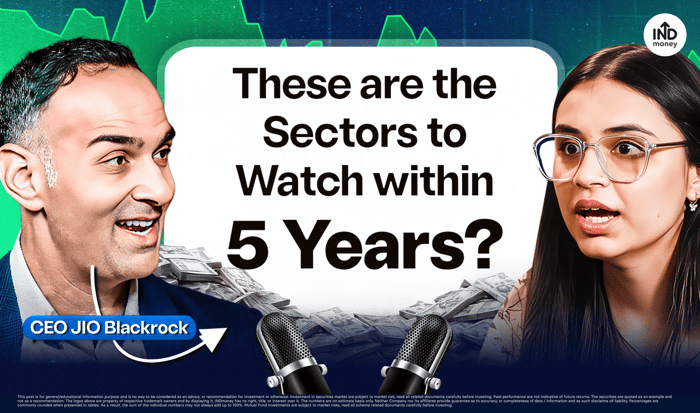
- More than Sectors, it’s about Macro Trends
- Understanding Macro Trends (in Simple Terms)
- India’s Growth Story: Manufacturing, AI, and Digitalization
- With so many NFOs, how should Investors choose?
- Jio BlackRock’s Expense Ratio: Lowest in the Industry?
- Conclusion
We recently had a podcast conversation with Sid Swaminathan, CEO of Jio BlackRock, and this is the second blog based on that discussion.
In this part of the conversation, we talked about which sectors could perform well over the next five years, and what factors investors should really be paying attention to.
More than Sectors, it’s about Macro Trends
When asked about which sectors are likely to do well, Swaminathan said that he focuses more on macro trends than on individual sectors.
But what does this mean? And how does it work in the markets?
Understanding Macro Trends (in Simple Terms)
Macro trends are significant, long-term economic or social shifts that affect multiple industries simultaneously.
Instead of looking at just one company or one sector, investors look at the broader forces driving change in the economy.
Here’s a simple way to understand it:
- They are long-term drivers – Macro trends can last for several years and shape how the economy grows.
- They cut across industries – A single trend (like digitalization) can benefit tech, finance, and manufacturing together.
- They reflect economic direction – In a growing economy like India, macro trends help identify where the next wave of opportunities may come from.
Here is the link to the blog.
India’s Growth Story: Manufacturing, AI, and Digitalization
Swaminathan pointed out that India’s manufacturing, AI, and digitalization sectors are important parts of this growth story.
- Manufacturing is expected to expand as India strengthens its production base and supply chains.
- AI (Artificial Intelligence) is driving productivity and innovation across industries.
- Digitalization continues to transform how businesses operate and how consumers engage with financial and retail services.
All these trends together form the foundation of India’s next growth phase.
With so many NFOs, how should Investors choose?
When asked about the large number of New Fund Offers (NFOs) coming out almost every day, Swaminathan said investors should start by asking themselves a simple question:
What am I trying to achieve in the short, medium, or long term?
- If you are bullish on the market, index funds are a simple way to participate in overall growth.
- If you want to beat the market, active funds may be the better choice.
In short, your fund choice should align with your goals and market outlook.
Jio BlackRock’s Expense Ratio: Lowest in the Industry?
Jio BlackRock currently offers one of the lowest expense ratios in the mutual fund industry, especially for its Flexi Cap Fund.
Given Jio’s track record of making products accessible to everyone, this approach naturally raises the question: Is this low expense ratio a way to reach and capture a large investor base?
Swaminathan explained that expense ratios matter because they compound over time. Lower costs mean more of your returns stay with you.
However, he also mentioned that Jio BlackRock is not competing with other players, but rather participating in a rapidly growing industry.
As of now, India’s mutual fund industry is worth over ₹75 trillion, and it continues to expand quickly as more investors enter the market.
Conclusion
Sid Swaminathan’s perspective offers a simple takeaway: instead of chasing individual sectors, focus on the broader trends shaping India’s economy.
As the country grows through manufacturing, AI, and digitalization, opportunities will naturally follow.
For investors, keeping long-term goals in mind, choosing funds wisely, and understanding costs like the expense ratio can make a real difference over time.
Disclaimer: The content is meant for education and general information purposes only. Past performance is not indicative of future returns. Mutual Funds are non-exchange traded products, and INDstocks is merely acting as a mutual fund distributor. All disputes with respect to distribution activity, would not have access to the exchange investor redressal forum or arbitration mechanism. Mutual Fund investments are subject to market risks, read all scheme related documents carefully before investing. INDstocks Private Limited (formerly known as INDmoney Private Limited) 616, Level 6, Suncity Success Tower, Sector 65, Gurugram, 122005, SEBI Stock Broking Registration No: INZ000305337, Trading and Clearing Member of NSE (90267, M70042) and BSE, BSE StarMF (6779), AMFI Registration No: ARN-254564, SEBI Depository Participant Reg. No. IN-DP-690-2022, Depository Participant ID: CDSL 12095500, Research Analyst Registration No. INH000018948 BSE RA Enlistment No. 6428.